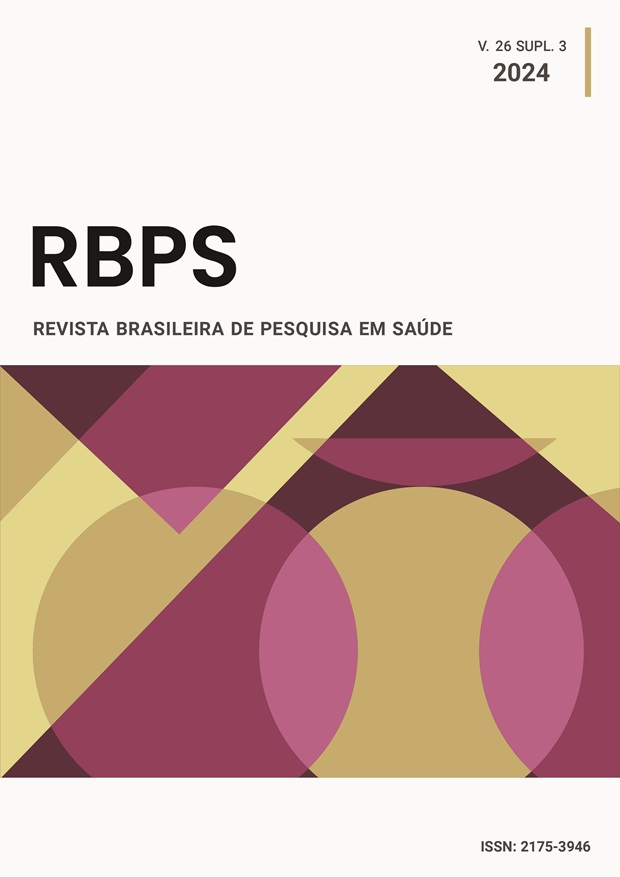Clinical-epidemiological profile of elderly HIV patients treated at a specialized care center in Vitória, ES, Brazil, in the post-HAART era
DOI:
https://doi.org/10.47456/rbps.v26isupl_3.01Keywords:
HIV, Aging, MultimorbidityAbstract
Introduction: Human immunodeficiency virus (HIV) infection remains a relevant public health issue. While most cases are concentrated in the younger population, the age group above 50 years is on the rise. Objective: To describe the clinical and epidemiological profile of elderly patients infected with HIV/AIDS in the post-HAART era followed at a reference center. Methods: This is an epidemiological, retrospective, qualiquantitative study conducted in the HIV/AIDS outpatient clinic of the Infectious Diseases Service at Cassiano Antônio Moraes University Hospital (Hucam). Results: Of the 60 patients, 60% were male and 40% were female. Self-declared, brown-skinned individuals, with 8-12 years of schooling and heterosexual preference, predominated. The majority (60%) had comorbidities, mainly cardiovascular diseases (37.3%) and endocrinological diseases (18%), with a focus on systemic arterial hypertension, diabetes mellitus, and dyslipidemia. Regarding origin, 65% came from the inpatient ward. Regarding the diagnosis period, 78.3% had a recent diagnosis of HIV/AIDS and 43.3% had opportunistic infections at diagnosis. The median value of CD4 T lymphocytes at the beginning of follow-up was 211.5 cells/µl, being 131 for patients from the inpatient ward and 393 for those from the outpatient clinic. The current CD4 T lymphocyte count was greater than 500 in 36.6% of individuals (71.4% and 17.9% when analyzing the outpatient and inpatient subgroups, respectively). Conclusion: The aging of the HIV/AIDS population with the advent of HAART is a global trend that brings new challenges to health services, requiring comprehensive geriatric assessment and individualized interventions that consider the specificities of the elderly population.
Downloads
References
1. NACO. Estatísticas globais sobre VIH e SIDA — ficha informativa de 2020 | ONUSIDA. Unaids.Org, 2020 [Internet]. Disponível online em: https://www.unaids.org/en/resources/fact-sheet. Acesso em: 25 fev. 2024.
2. Ministério da Saúde (BR). Secretaria de Vigilância em Saúde. Boletim Epidemiológico Aids 2023 [Internet]. Brasília: Ministério da Saúde; 2021. Disponível em:https://www.gov.br/aids/pt-br/central-de-conteudo/boletins-epidemiologicos/2023/hiv-aids/boletim-epidemiologico-hiv-e-aids-2023.pdf. Acesso em: 25 fev. 2024.
3. Cardoso SW, Torres TS, Santini-Oliveira M, Marins LMS, Veloso VG, Grinsztejn B. Aging with HIV: a practical review. Rev Bras Epidemiol [Internet]. 2019 Mar [cited 2024 Feb 25]; 22:e190033. doi: 10.1590/1980-549720190033.
4. Aguiar RB, Leal MCC, Marques AP de O, Torres KMS, Tavares MTDB. Idosos vivendo com HIV – comportamento e conhecimento sobre sexualidade: revisão integrativa. Ciênc. saúde coletiva [Internet]. 2020 Feb [cited 2024 Feb 25];25(2):575–84. DOI https://doi.org/10.1590/1413-81232020252.12052018.
5. Silveira, MM da, Batista JS, Colussi EL, Wibelinger LM. Sexualidade e Envelhecimento: discussões sobre a AIDS. Rev Temát Kairós Gerontol. 2011;14(5).
6. Blanco JR, Jarrín I, Vallejo M, Berenguer J, Solera C, Rubio R, et al. Definition of advanced age in HIV infection: looking for an age cut-off. AIDS Res Hum Retroviruses. 2012 Sep;28(9):1000-6. doi: 10.1089/AID.2011.0377.
7. Roomaney RA, van Wyk B, Pillay-van Wyk V. Envelhecimento com HIV: Aumento do risco de comorbidades do HIV em adultos mais velhos. Internacional J. Meio Ambiente. Res. Saúde Pública. 2022;19:2359. DOI https://doi.org/10.3390/ijerph19042359.
8. Serrão R, Piñero C, Velez J, Coutinho D, Maltez F, Lino S, et al. Non-AIDS-related comorbidities in people living with HIV-1 aged 50 years and older: The AGING POSITIVE study. International Journal of Infectious Diseases 79 (2019) 94–100. DOI https://doi.org/10.1016/j.ijid.2018.10.011.
9. Dantas RS, Moura JC, Silveira KM, Aragão MT. Perfil epidemiológico dos pacientes idosos com HIV em um centro de referência de Aracaju-SE. Rev Epidemiol Controle Infecç. 2020 abr-jun;10(2):135-139. Disponível em: https://doi.org/10.17058/jeic.v10i2.14498.
10. Ferreira TC, Souza APC, Rodrigues JRS. Perfil clínico e epidemiológico dos idosos portadores do HIV/AIDS de uma unidade de referência em Belém-PA. Rev Univ Vale Rio Verde. 2015;13(2):45-55.
11. Carlos AdM, Lopes EHS, Alves APF, Gouveia ADM, Filho JELdO, Fachin LP. O perfil epidemiológico da HIV/AIDS em idosos no Brasil, entre 2015 e 2019 / The epidemiological profile of HIV/AIDS in elderly patients using datasus’health information system, between 2015 and 2019. Braz J Dev. 2022;8(2):13046–13055. DOI https://doi.org/10.34117/bjdv8n2-304.
12. Silva EM da, Santos BS, Santos GV da S, Freire AR de J, Valentim AR, Gomes ALF, et al. Epidemiological profile of AIDS in the elderly in the municipality of Aracaju – Sergipe. Research, Society and Development [Internet]. 2022 [cited 2024 Mar 3];11(10). DOI: 10.33448/rsd-v11i10.32810.
13.Wing EJ: HIV and aging [Internet]. Int J Infect Dis 2016 [cited 2024 Feb 25];25(2):575–84;53:61–68. Available from: https://www.ijidonline.com/article/S1201-9712(16)31187-0/fulltext. Acesso em: 03 mar. 2024.
14. Richterman A, Sax PE. Antiretroviral therapy in older people with HIV. Curr Opin HIV AIDS. 2020 Mar;15(2):118-125. doi: 10.1097/COH.0000000000000614. PMID: 31990705.
15. Madi D, Ramakrishnan N, Unnikrishnan B, Ramapuram J, Achappa B, Rathi P. Perfil clínico-epidemiológico de idosos PVHIV que frequentam um centro de cuidados terciários no sul da Índia. Jornal da Associação Internacional de Provedores de Cuidados com a AIDS (JIAPAC). 2017;16(6):620-623. DOI: 10.1177/2325957417742672.
16. Martin-Iguacel R, Llibre JM, Friis-Moller N. Risk of cardiovascular disease in an aging HIV population: where are we now?. Curr HIV/AIDS Rep. 2015;12:375-387.
17. Freiberg MS, Chang CC, Kuller LH, Skanderson M, Lowy E, Kraemer KL, et al. HIV infection and the risk of acute myocardial infarction. JAMA Intern Med. 2013;173:614-622.
18. Klein DB, Leyden WA, Xu L, Chao CR, Horberg MA, Towner WJ, et al. Declining relative risk for myocardial infarction among HIV-positive compared with HIV-negative individuals with access to care. Clin Infect Dis. 2015;60:1278-1280.
19. Nansseu JRN, Bigna JJR, Kaze AD. Prevalence of dysglycemia in HIV-infected patients: A systematic review and meta-analysis of epidemiological studies. PLoS One. 2018 Mar 14;13(3). doi: 10.1371/journal.pone.0194199.
20.Obimakinde AM, Adebusoye L, Achenbach C, Ogunniyi A, Olaleye D. Beyond Giving Antiretroviral Therapy: Multimorbidity in Older People Aging with HIV in Nigeria. AIDS Res Hum Retroviruses. 2020 Mar;36(3):180-185. doi: 10.1089/AID.2019.0131.
21. Alencar RA, Ciosak SI. AIDS em idosos: motivos que levam ao diagnóstico tardio. Revista Brasileira de Enfermagem [Internet] 2016 [cited 2024 Mar 25]; 69(6):1140-1146. Disponível em: http://www.scielo.br/pdf/reben/v69n6/0034-7167-reben-69-06-1140.pdf.
22. Brañas F, Serra JA. Infeccíon por el virus de la inmunodeficiencia humana en el anciano. Rev Esp Geriatr Gerontol [Internet]. 2009 [cited 2024 Mar 25];44(3):149-54. Available from: http://www.ncbi.nlm.nih.gov/pubmed/19443084
23. Zhao H, Feng A, Luo D, et al. Factors associated with immunological non-response after ART initiation: a retrospective observational cohort study. BMC Infect Dis. 2024;24:138. doi:10.1186/s12879-024-09021-9.
24. Kaufmann GR, Furrer H, Ledergerber B, Perrin L, Opravil M, et al. Characteristics, determinants, and clinical relevance of CD4 T-cell recovery to <500 cells/μL in HIV type 1-infected individuals receiving potent antiretroviral therapy. Clin Infect Dis. 2005 Aug 1;41(3):361-372. doi:10.1086/431484.
Downloads
Published
How to Cite
Issue
Section
License
Copyright (c) 2025 Brazilian Journal of Health Research

This work is licensed under a Creative Commons Attribution-NonCommercial-NoDerivatives 4.0 International License.
Authors and reviewers must disclose any financial, professional, or personal conflicts of interest that could influence the results or interpretations of the work. This information will be treated confidentially and disclosed only as necessary to ensure transparency and impartiality in the publication process.
Copyright
RBPS adheres to the CC-BY-NC 4.0 license, meaning authors retain copyright of their work submitted to the journal.
- Originality Declaration: Authors must declare that their submission is original, has not been previously published, and is not under review elsewhere.
- Publication Rights: Upon submission, authors grant RBPS the exclusive right of first publication, subject to peer review.
- Additional Agreements: Authors may enter into non-exclusive agreements for the distribution of the RBPS-published version (e.g., in institutional repositories or as book chapters), provided the original authorship and publication by RBPS are acknowledged.
Authors are encouraged to share their work online (e.g., institutional repositories or personal websites) after initial publication in RBPS, with appropriate citation of authorship and original publication.
Under the CC-BY-NC 4.0 license, readers have the rights to:
- Share: Copy and redistribute the material in any medium or format.
- Adapt: Remix, transform, and build upon the material.
These rights cannot be revoked, provided the following terms are met:
- Attribution: Proper credit must be given, a link to the license provided, and any changes clearly indicated.
- Non-Commercial: The material cannot be used for commercial purposes.
- No Additional Restrictions: No legal or technological measures may be applied to restrict others from doing anything the license permits.

























